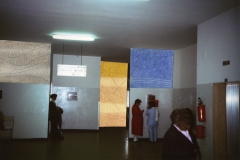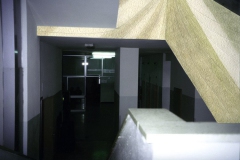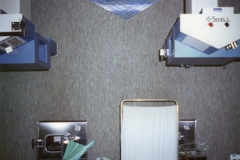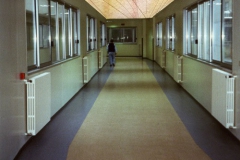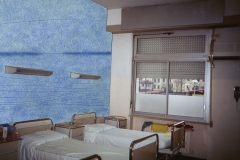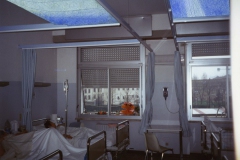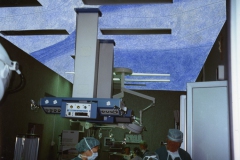
The goal of the project is to be related to a new vision of the relationship between man and hospitals. Hospital structures are seldom realised with a correct, sensitive attention to the patients as human beings. More consideration, although still insufficient, is given to the staff. The target is the utmost technologic efficiency, often neglecting the human element.
In fact, over the past few years this last aspect has been taken into consideration, especially in the paediatric field, thanks to the sensitivity shown by some of the workers in the field and by associations of parents.
There is a talk of a ‘humanisation’ of hospitals, which is a revealing sign of the distance that separates us from certain basic principles: the triumph of technology has led hospital structure to become, not always and not everywhere, but often, only a diagnosis and therapy factory, and not a place for human relationships. I would like to remind you how those who enter the hospital leave behind their everyday life and their familiar surroundings, to be immediately received by feelings of alienation and isolation, that cause anxiety and discomfort.
Let us return to Schweitzer’s observation, which might otherwise appear obvious and banal, remembering that that expression had its foundations in the way he managed his hospital. Albert Schweitzer was somehow predicting a way of conceiving health which would later be redefined, firstly with the Declaration of Alma-Ata: “…to produce a change in the attitude and in the organisation of health services, so that they develop focusing especially on the needs of the individual as a whole”.
A few years later, the Chart of Ottawa reaffirmed: “Moreover, health is not seen as a goal, but as a source of wealth in daily life. (…) As a consequence, given that the concept of health, as in ‘well being’, goes beyond the idea of ‘a healthy life style’, the promotion of health does not concern the health services only’.
I would like to begin my presentation with the words of Albert Schweitzer, who, in 1913, started his fantastic adventure of a family-hospital in Lambaréné, to be abruptly interrupted by his death, after which the hospital become entirely based on technology. In his book Respect for life, Schweitzer says: I am a human being who wants to live, surrounded by other human beings who want to live”. We will go back to this concept later.
The title of my paper might lead to assume that I have already identified a hospital in Tuscany on which to operate with a definite artistic project. Political authorities have expressed their intentions in this regard, but there are obviously still steps to be taken to get to a proper project, which, however, could not be described adequately here. What I will present you with, is an approach to the theme, with visual cues and some sketches of an intervention on a part of a hospital structure.
The images illustrating this paper should function as lightning flashes: as such, they should not be looked at as an orderly acquisition, but as a free association of ideas. The images are taken from urban, rural, public and private settings, scattered in a panoramic view that unites the need to represent an environment dose to us, with a wider opening on the world.
Among the above mentioned images are some hypothesis of intervention on hospital environments, that I created with the aim of illustrating, albeit partially, what I mean by ‘an intervention related to the structure’.
I will now quote a short passage from The gift of the magic herbs (Ling Mengchu, Ming period, 1580-1644): ‘I will now tell you the story of a fox-spirit, tied with love to a man, that left him the gift of healing herbs which not only cured the man from his illness, but also made him find a wife, fulfilling a happy destiny’. What we have just read offers us an exemplary explanation of what I wanted to express in the two declarations mentioned above: that is to say, the state of health in a sick body depends on a much more complex route that the simple healing of the illness. We are not trying to doubt the importance of the structure and of the medical staff here, we just want to look at a different approach to the patient.
Let us reconsider the words of the Chinese story. There is love, which must al-ways accompany the therapy, there are the ‘healing herbs’: even that is not enough, the need for a holistic vision of man is given voice to. Therefore, I think that any environment man has to live and work in must contain all the elements life is made of, from everyday gestures to fantasy and imagination: moreover, hospitals are places in which various kinds of different people live and operate (the sick, the medical staff, visiting relatives and friends). Imagination is certainly the most neglected element in our hospital structures: this is the function that visual arts must perform. Art must enter the rooms on tiptoe, with a respectful touch, with human warmth, with transparent intentions: qualities all related with aesthetics, which is a rather peculiar way to enhance the quality of life.
I believe these must be the guiding lines of a project, in order to give way to a confrontation between the artists and hospital structures: they can be summed up in the concepts of imagination, lightness, harmony.
When I talk about planning visual art in a hospital, I mean that the entire structure must be involved, even its most intimate parts, that is to say the wards where the patients stay. This involves the creation of attractions for the eye in the rooms of the hospital.
To offer the ill, and not only, a visual anchor, means to hand in a space that has points where tension, a part of the therapy both on the receiving and on the giving end, can be let off. If we offer an attraction to the eye, in suitable places, we believe we can break the circle of tension and anxiety created by therapeutic practices, by means of the sense of sight.
A differentiation of the object of the patient’s gaze (toward a flux of routes, a light, a shape) helps him not to develop an obsessive attitude. I believe that our hospital structures, where both the colour white and the serialisation of furniture still prevail, have a hypnotic effect on patients, this generating a situation of total passivity. This is not the most suitable state to activate the process of self-preservation.
To put signs of art in the rooms offers a kind of harmony in the objects, that can help the ill in their relationship with their disease: I mean that, as the illness is a fracture in the interior harmony of our body, to give the ill something that possesses the characteristics of an object-harmony might create more suitable psychological space, leading to a reinstatement of the broken balance. On the other hand, cold surroundings can work as a resonance box for anxiety. In the last analysis, the goal is to oppose the feelings of alienation and isolation through feelings of regeneration, which should stem from the contact with artistic objects.
When I chose to use in my paintings signs and glazing of colour only, I had it very clear in my mind that what I wanted to achieve was ‘lightness’, as a very positive element. Quoting Italo Calvino’s American Lessons, I might say that “… my operation was, most of the times, a subtraction of weight; (…) Lightness, for me, is associated with precision and determination, and not with vagueness and fatefulness”.
I have always had interest in large spaces (the background), characterised by lightness and transparency; at the same time, by stratification and great rich-ness of details: these spaces are marked by signs, crossing the pictorial surface like tracks on the ground in a large landscape.
In this way, there is no loss of history, there is no loss of variety, nor of complexity, even in the apparent absence of representations. If the gaze can lie on something (a line, a route within a colour) which can push the mind into the world of imagination, then it manages to recreate the vital flux between the mind and the body, which is the basis of any therapeutic success. We need to find a new way to look at the world, a lighter way, more transparent, less aggressive, with more empty spaces, more silence, in order to listen to a possible dialogue between ethics and aesthetics.
Therefore beauty can be used as a means of overcoming discomfort, and in a direct dialogue with the ethical element, such as a health institution. It must be made clear that any artistic project on a hospital structure must contain a variety of voices, because a diversified stimulus is, without a doubt, richer both psychologically and emotionally.
While carrying out the various interventions, we must take into account the diversity of situations within the various environments of the hospital structure: the presentation of the building on the outside (sculptures, installations, light signs), the halls, the corridors and staircases as transit areas (great mural paintings, installations on the walls, light spots, photographs), the waiting areas, where the patients and the staff have to stop (great mural paintings, installations, photographs, videos), wards and operating theatres, where the stay is longer (murals on the walls and especially on the ceilings, videos). AH this should not be achieved just by placing artistic objects inside the hospital structure (which, incidentally, would not cause any harm, anyway), but by means of a focused research, involving the various different structures within the hospital. I therefore hope that the artists involved in the realisation of works of art for hospitals, will be able to operate in direct contact with life in a hospital, for a correct accomplishment of my project.
AH this must be carried out according to the principles I enounced above, that is to say harmony, lightness, imagination.The images I presented and the sketches I drew have the purpose to make obvious a part of what can be considered the starting platform for this project,which I hope will be put into practice soon.
In conclusion, I would like to remind you briefly of the images we have seen*: Let us for a spin, a slow and healthy ride, intimate and public, from videogames to a remote past of the present, diving into contemporary times. Surface and depth, with a convulsive beat that sharpens your mind. We enter what appears to be a chemist’s: there is the passion of love and that of the landscape, not far from home, remembering childhood, in telecommunication with the good things, beautiful colours, the city, the astral city. We will build having history in mind, with its architectures, with possible contemporary weddings. Surface, underneath the surface, private, public, an eye opens up in the sky, embracing the present-past, we enjoy whatever good things our grandfathers’ history left us with, playing with water, making rafts. Greenery in Bolivia, greenery in the Bronx, a crane in Berlin, the subway in New York City, bring us far away, dose to the Venus of Milo, to the Kino of Kassel, the sky above Manhattan, San Galgano, Villa Solaria, Gravina in Puglia; Red as the airplane flying above the towers of Chicago, the house at Tonda, the favela of Saint Marta, a dream of music and seafarers at La Boca, the Weeping Wall. Bicycles, a cauliflower on the table, Hering at Munster, la puerta de la luna, aerials in Naples, the citadel, signs and signs and signs, the stone. And then, the hospital.
